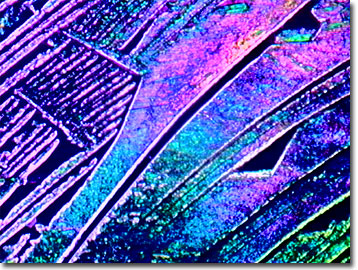Polarized Light Digital Image Gallery
Leptin
A protein hormone, leptin is manufactured in adipose tissue (fat cells) and acts on receptors in the hypothalamus of the brain. The level of circulating leptin is directly proportional to the total amount of fat in the body and leptin helps maintain the homeostatic control of food intake.

In the brain, leptin counteracts the effects of two potent feeding stimulants known as neuropeptide Y and anandamide. Interestingly, leptin binds to the same receptor on anandamide as tetrahydrocannabinol (THC), the active ingredient of marijuana, lending some physiological credence to the marijuana "munchies." As another inhibition to additional food intake, leptin promotes the effects of alpha-MSH, an appetite suppressant. Without this functioning hormone or its receptors, uncontrolled food intake leads to obesity. Leptin also acts directly on the cells of the liver and skeletal muscle by stimulating the oxidation of fatty acids found in the mitochondria. Thus, the storage of fat in these tissues, but not adipose tissue, is reduced through leptin's actions.
Women have significantly more leptin than men, but when compared by percent of body fat, leptin levels were similar. The name leptin is derived from the Greek root for thin, leptos, and the biochemical was discovered in 1995 by Dr. Jeffrey Friedman of New York's Rockefeller University and his colleagues. Synthesized and recombinant genetically-biosynthesized leptin decrease the body weight of mice by reducing food intake and increasing energy expenditure. There also seemed to be an improvement in non-insulin-dependent diabetes mellitus with the addition of leptin, with normalization of serum insulin levels and glucose tolerance. However, obese animals seem to require proportionally more leptin for similar actions, implying that obesity affects the efficiency of leptin's satiation functions.
More recently, receptors for leptin were discovered in newly sprouting capillaries and in the T cells of the immune system. This points to leptin as a multifunction hormone, and not just one that regulates appetite and weight gain. Research on the formation and growth of tumors through the creation of new capillaries and the role of T cells fighting infections in HIV/AIDS appears promising with regards to the role of leptin in future therapies.
Contributing Authors
Omar Alvarado, Thomas J. Fellers and Michael W. Davidson - National High Magnetic Field Laboratory, 1800 East Paul Dirac Dr., The Florida State University, Tallahassee, Florida, 32310.
BACK TO THE POLARIZED LIGHT IMAGE GALLERY
BACK TO THE DIGITAL IMAGE GALLERIES
Questions or comments? Send us an email.
© 1995-2025 by Michael W. Davidson and The Florida State University. All Rights Reserved. No images, graphics, software, scripts, or applets may be reproduced or used in any manner without permission from the copyright holders. Use of this website means you agree to all of the Legal Terms and Conditions set forth by the owners.
This website is maintained by our
Graphics & Web Programming Team
in collaboration with Optical Microscopy at the
National High Magnetic Field Laboratory.
Last Modification Friday, Nov 13, 2015 at 01:19 PM
Access Count Since September 17, 2002: 13032
Visit the website of our partner in introductory microscopy education:
|
|
